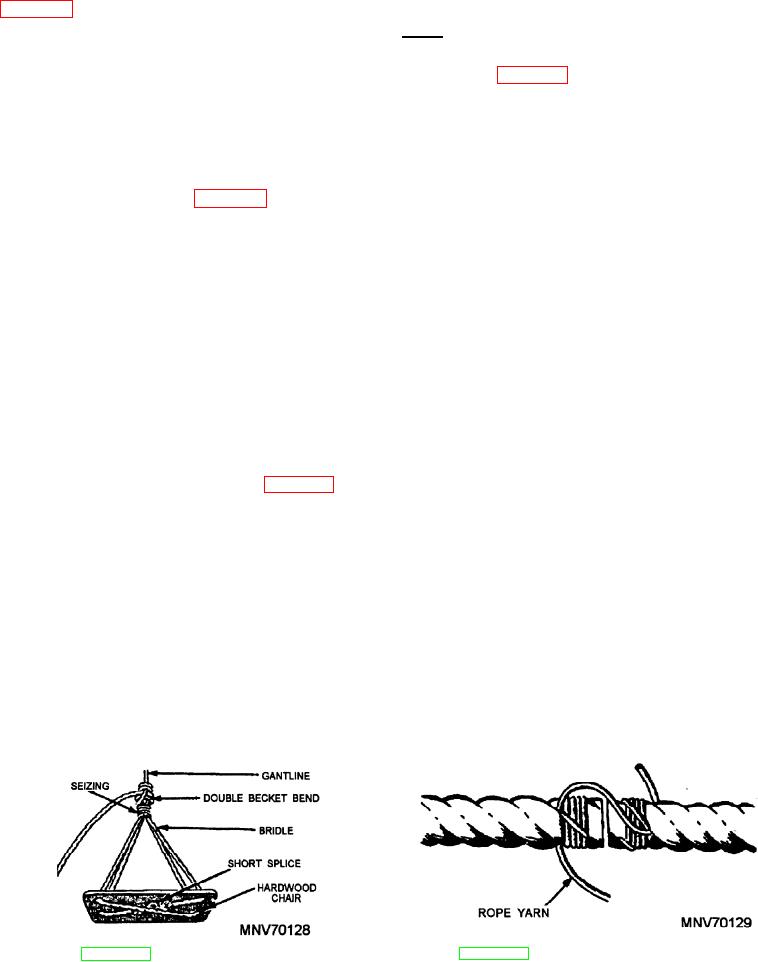
dummy gantline and then use the dummy gantline to
fantail. These are normally smaller pneumatic fenders
pull the chair gantline through the sheave. If there were
or homemade manila fenders about 4 feet long and 1
no dummy gantline, someone would have to climb the
foot in diameter. The Navy-type fender is shown in
topmast to reeve the chair gantline through the sheave.
Never let the end get away from you and reeve out.
CAMELS
A recommended method of securing gantlines is
diagrammed in figure 5-5. The end of the chair gantline
Camels are used to protect a fender system from
is secured to the end of the dummy gantline by butting
damage due to the motion of moored ships and, where
the two ends together and seizing the ends with turns of
necessary, to provide proper clearance between a ship
rope yarn back and forth between strands, so the joint
and a wharf or pier. Camels are floating separators that
will pass through the sheave without fouling. In use, the
can be attached to a fender system, the wharf, pier, or the
chair gantline is hauled up and through by the dummy
ship itself. The camels that are generally used for
gantline, the chair is heaved from the deck to the
mooring a ship are shown in figure 5-3.
crosstree, and the hauling part is passed down to the
personnel or deck crew.
THE SEAMAN ALOFT
Never let anyone attempt to hoist the chair aloft
As a Mineman in the deck division, you will be
with the dummy gantline. Be sure all your tools and
involved in painting or doing repairs while working
equipment are attached to the chair so that your hands
either aloft or over the side. To do these tasks safely, you
are free and to ensure the safety of anyone below from
must be able to rig and use both the boatswain's chair
falling objects. When you are ready to go up, and the
and the stage correctly. You must also know the safety
deck crew is ready to heave around, get into the chair
precautions involved in working aloft and over the
and give a signal to be pulled up. Assist the deck crew
side.
by hauling down on the hauling part. Keep your hands
clear of the part the chair is on or they may get jammed
BOATSWAIN'S CHAIR
into the sheave when you are two-blocked to the truck.
When you reach your desired working height, signal the
The boatswain's chair is a hardwood seat attached to
crew below to "Hold what you got". The deck crew will
a double bridle of stout line, as shown in figure 5-4. It is
stop pulling and hold the chair in place. Reach above the
always bent to the gantline by a double becket. A length
double becket bend with your left hand and firmly
of slack line is left hanging, as shown in the figure, for
squeeze the two parts of the gantline together. When
use in securing the chair to a mast, or in staying aloft.
you have a good grasp, command the deck crew Up
behind. This tells them to let go of the gantline.
For a straight drop, as when painting down a mast,
rig the chair for self-lowering. When you ascend a mast,
you will often find that the ladder takes you only to the
WARNING
crosstree. You must be hoisted from there to the truck
(top of the mast) by personnel on deck. When there is no
At this point, your grasp is all that is
way of getting to the truck by ladder, a dummy gantline
keeping the chair from falling. With your right
is usually left reeved from the cross-tree up through the
hand, pull the gantline through the bridle and
sheave (pulley) at the truck and back to the crosstree.
squeeze the three parts together just above the
This allows you to attach the chair gantline to the
double becket bend.
Figure 5-5.--Method of securing gantlines.
Figure 5-4.--The boatswain's chair.
5-3

